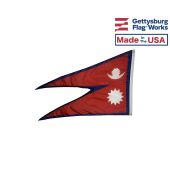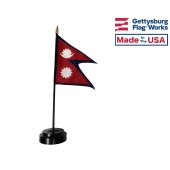Buy Nepal Flags
Flag of Nepal
It is impossible to mistake the flag of Nepal for the flag of any other nation because it is the only flag in the world that is not a quadrilateral of any kind. It is a combination of two pennants that have been used individually for hundreds of years and that draw on a tradition that stretches back for even longer, which makes the Nepal flag a remnant of the past that is still serving as a symbol of its nation in the modern day.
- Capital of Nepal: Kathmandu
- Area of Nepal: 136,800 sq. km
- Languages used in Nepal: Nepali, Maithali, Bhojpuri, Tharu (Dagaura/Rana), Tamang, Newar, Magar, Awadhi
- Religions in Nepal: Hindu, Buddhist, Muslim, Kirant
Colors and Symbolism: Nepal Flag Meaning
The Nepal flag has a unique shape that is made up of a pair of pennants that have been put together. The flag has a solid red field with a blue border, and each of the pennant sections has an emblem. The upper section has a stylized depiction of the crescent moon, while the lower section depicts the sun. Both of the emblems are white.
The red field is the same shade as the country's national flower, but it also serves as a symbol of military victory. The blue border is a symbol of peace, which allows it to add both visual and symbolic contrast to the flag's design. The combination of the sun and moon gives the Nepal flag meaning as a symbol of the nation's spiritual virtues. The moon is used to symbolize calm serenity, while the sun offers a symbol of ferocity and firm resolution. When they are taken together they embody the hope that the nation of Nepal will endure for as long as the celestial bodies themselves.
History of the Nepal Flag
The flag of Nepal is derived from a flag that was instituted more than two hundred years ago by Prithvi Narayan Shahm, the king who unified many small states to form the modern nation. His flag had human faces on the sun and moon, but it otherwise followed the same design as the current flag. The faces were removed from the flag in 1962 in order to give the Nepal flag meaning as a symbol of modernity in addition to the state's traditional values. The change happened at the same time that the country transitioned to a constitutional government, and it has been used for the entirety of the time that the constitution has endured.






